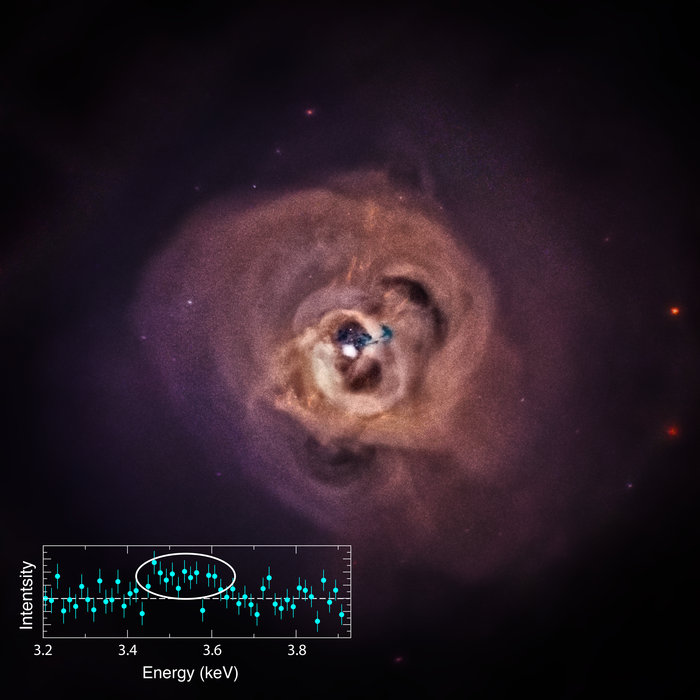We can't even define dark matter, other than it being some blanket term for something that must exist due to unexplainable gravitational influence on the movements and appearance of stars or galaxies.
Based on indirect evidence, astronomers believe that dark matter is the dominant type of matter in the Universe – everything else has been conjecture. But astronomers using high-energy observatories believe they may have discovered a clue that hints at this elusive invisible ingredient.
Galaxy clusters not only contain hundreds of galaxies, but also a huge amount of hot gas filling the space between them. By studying galaxy clusters, the largest cosmic assemblies of matter bound together by gravity, and measuring their gravitational influence, astronomers have deduced that galaxies and gas make up only about a fifth of the total mass. Everything else falls into the black box called dark matter.
The Perseus galaxy cluster in this image revealed a mysterious X-ray signal in the data. This signal is represented in the circled data points in the inset, which is a plot of X-ray intensity as a function of X-ray energy. The signal is also seen in over 70 other galaxy clusters using XMM-Newton. This unidentified X-ray emission line – a spike of intensity centred on about 3.56 keV – requires further investigation to confirm both the signal’s existence and nature. One possibility is this signal is the decay of ‘sterile neutrinos’, one proposed candidate to explain dark matter. Credit:
NASA/CXC/SAO/E.Bulbul, et al.
The gas is mainly hydrogen and, at over 10 million degrees celsius, is hot enough to emit X-rays. Traces of other elements contribute additional X-ray ‘lines’ at specific wavelengths.
Examining observations by ESA’s XMM-Newton and NASA’s Chandra spaceborne telescopes of these characteristic lines in 73 galaxy clusters, astronomers stumbled on an intriguing faint line at a wavelength where none had been seen before.
“If this strange signal had been caused by a known element present in the gas, it should have left other signals in the X-ray light at other well-known wavelengths, but none of these were recorded,” says Dr. Esra Bulbul from the Harvard-Smithsonian Center for Astrophysics and lead author of the paper discussing the results.“So we had to look for an explanation beyond the realm of known, ordinary matter.”
The astronomers suggest that the emission may be created by the decay of an exotic type of subatomic particle known as a ‘sterile neutrino’, which is predicted but not yet detected.
Ordinary neutrinos are very low-mass particles that interact only rarely with matter via the so-called weak nuclear force as well as via gravity. Sterile neutrinos are thought to interact with ordinary matter through gravity alone, making them a possible candidate as dark matter.
“If the interpretation of our new observations is correct, at least part of the dark matter in galaxy clusters could consist of sterile neutrinos,” says Bulbul.
Preprint: Esra Bulbul, Maxim Markevitch, Adam Foster, Randall K. Smith, Michael Loewenstein, Scott W. Randall, 'Detection of An Unidentified Emission Line in the Stacked X-ray spectrum of Galaxy Clusters', arXiv:1402.2301





Comments